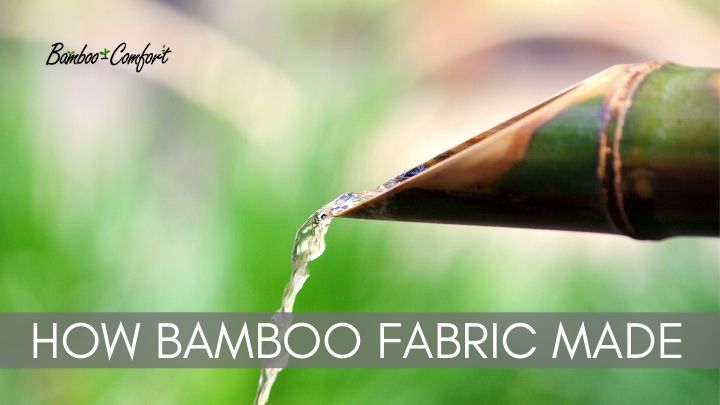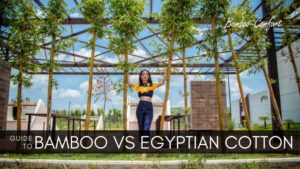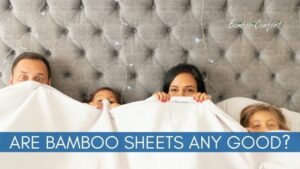Ever wonder how they can make a soft fabric from something as strong and tough as bamboo? Or how they transform the raw material that’s strong as steel into clothes and sheets?
Like myself and many others, I’m sure you did too!
After some research I’ve found out that it’s not that complicated. In fact it only takes 4 steps to turn raw bamboo stalks into bamboo fabric.
4 Steps Companies use to make Bamboo Fabrics
How Bamboo Fabric is Made
Below, I’ll provide some details of the 4 steps many companies use to turn bamboo into soft fabric.

Step 1: Harvesting the Bamboo
It all starts with the harvesting of the mature bamboo plants.
At that time the bamboo stacks are between 2 and 4 years old. Bamboo is actually a weed and grows naturally in many parts of the world. That’s what makes bamboo plants resistant to insects and diseases.
Fact- Bamboo is naturally resistant to pests and harmful insects. Unlike other cultivated plants such as cotton, that require harmful pesticides to grow.
Cutting the bamboo stacks as cleanly as possible will make it easier for the new shoots to grow. Some species of bamboo can grow as much as 2 to 4 feet per day! Bamboo replenishes and fully matures in about 3 years.
Compare that to the 40-60 years it takes a hardwood maple tree to reach full maturity.
After harvesting the bamboo, it’s transported to factories located near by. From there, they’re chopped up into smaller “chunk-like” pieces and sent off to the the next process.
This results in massive piles of raw bamboo chips that are easier to handle and transport.
Step 2: Soaking the Bamboo
Most bamboo manufacturers use an Eco-friendly soaking solution to soak the bamboo chips. This method uses chemicals to extract the cellulose from the chips.
The liquid solution follows the “Global Organic Textile Standard” of approval. Making the chemicals in the liquid as Eco-friendly as the bamboo soaking in it. This breaks down the bamboo chips, and converts them into a pulp.
Fact – Bamboo is one of the most environmentally friendly plants in the world! Compared to cotton, bamboo uses 1/3 the amount of water to grow.
The chemicals in the soaking solution are kept in a closed-loop system that allows it to be recycled over and over. Don’t worry, there won’t be any traces of the chemicals left by the end of the process.
The pulp resembles wet cotton and is ready to move to the following step.
This is the best time to add colors and dyes to the bamboo pulp. Adding the colors and dyes now, helps prevent fading and discoloration of the fabric.
Step 3: Processing the Bamboo Pulp
After soaking in the solution for a long period of time, the bamboo pulp will have a chance to rest and break down.
The bamboo pulp is wet and full of liquid from the soaking process. This makes it difficult for handling, transporting and storing the material.
Fact – 100% Viscose from Bamboo is softer than 1000tc Egyptian cotton and more comfortable as well.
Companies drain and press the pulp, recycling the soaking solution for the next batch. This forms parchment like sheets that are easy to handle and ideal for storage.
The sheets will also weigh a lot less after drying making them much easier to transport. Once dried, the parchment like bamboo sheets are stored until ready for the final step.
Step 4: Spinning the Bamboo Sheets into Fibers
Finally when the sheets are completely dried, they’re ground up and spun into Bamboo Fiber. A soft fluffy material resulting in a fabric twice as soft as cotton.
Manufacturers use a process to separate and spin the fiber into threads. Afterwards they create a basic weaving yarn that’s referred to as Bamboo Viscose.
Fact- Bamboo fabric can be two times softer than egyptian cotton and many compare it to Silk and Cashmere.
We use Thread Count to determine the quality of most bed sheets. Unlike cotton, the best bamboo sheets don’t need a high TC to be as soft or as strong.
With the right care, bamboo products can last up to 3 times longer than similar cotton products. Bamboo underwear and bamboo panties can last 5 times longer than cotton.
Companies are becoming more and more creative with what products to make from bamboo viscose. Many products are made from bamboo today, including bamboo socks, shirts pants and underwear.
Video | How do they make bamboo fabric?
I know many of us don’t like to read posts and articles. So here’s a quick video explaining the basic process of making bamboo fabrics.
Conclusion
Some bamboo products may seem less expensive than others. For example; products made from “Bamboo Rayon” tend to be a bit cheaper than bamboo viscose.
To be sure you’re getting the best possible quality and the full benefits of bamboo, look for 100% bamboo viscose on the label.
Follow us on bamboo-comfort.com. Find updated reviews and gather information about the latest bamboo products all in one place. Give us your feedback and share with us below. We want to hear your stories and experiences you’ve had with Bamboo.


